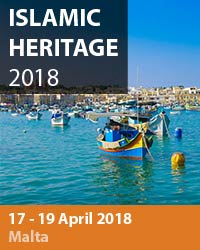Islamic Heritage 2018
2nd International Conference on Islamic Heritage Architecture and Art
![]()
17 - 19 April 2018
Malta
Overview

The 2nd International Conference on Islamic Heritage Architecture and Art recently took place in Malta, organised by the Wessex Institute, represented by Prof Giorgio Passerini. The meeting was co-sponsored by WIT Transactions on the Built Environment and the International Journal of Heritage Architecture.
The conference was reconvened following the success of the first meeting in the series which was held in Valencia, Spain, in 2016. Presented papers dealt with the design of many types of buildings in Islamic countries including, not only the better known public buildings, like mosques, mausolea, citadels and forts, but also houses and gardens, and many others which have also had a profound impact on society.
Islamic Architecture has enriched design with a wide variety of structural shapes including, among others, unique arches, a wide variety of vaults and domes which allow for new forms to be developed.
As conventional energy resources become scarce, Islamic design heritage can offer invaluable lessons on how to deal in an efficient manner with cases of hard and extreme environments.
Traditional architecture and urban environment in most Islamic countries are now being eroded by overemphasis on global types of architecture and city planning. As a consequence, many regions are losing their identity. The Conference looked at these developments in the light of what the classical Islamic urban designs and architectures have to offer modern society.
Opening of the Conference
Prof Passerini welcomed the delegates in the name of the Wessex Institute and hoped that they would enjoy their visit to Malta, with its historical towns and villages. Valletta, its capital, was declared European Capital of Culture in 2018, together with Leeuwarden-Friesland in the Netherlands.
Giorgio then explained the aims of WIT, for example providing a medium for knowledge transfer at an international level. This objective is achieved through a series of activities, i.e. meetings, including conferences; research at postdoctoral level; publications; and consultation services for industry.
The publication of papers is Open Access, which contributes to providing the widest dissemination possible to the work. Papers archived in our WIT eLibrary (https://www.witpress.com/elibrary) are downloaded in increasing numbers from colleagues around the world.
Most suitable for this conference is the International Journal of Heritage Architecture, which deals with studies, repairs and maintenance issues. One of the aims of the Journal is to achieve a better understanding of the influences and cross-fertilisation of different cultures.
Conference Topics
The Conference sessions had the following headings:
• Mosques and Minarets
• Heritage Architecture
• Adaptation of the Islamic heritage in the Modern City
• Heritage Interventions between Constants and Variables
• Heritage Studies
Invited Speakers
The meeting was enhanced by a series of invited presentations, as follows:
• “Sufism in the Architectural Typology of the Melaka Tengkera Mosque, Malaysia”, by Azizi Bahauddin, University Sains Malaysia, Malaysia
• “Using multimedia in documenting and archiving the Islamic architectural heritage of the Holy Mosque area in Makkah city”, by Reem Alsabban, King Abdulaziz University, Saudi Arabia
• “The impacts of the UNESCO's built heritage conservation policy (2010-2020) on historic Jeddah built environment”, by Mohammed Bagader, Effat University, Saudi Arabia
The Island of Gozo
On the first day a guided tour to the island of Gozo was organised, starting at Mgarr Harbour. This picturesque harbour is full of all manner of sea craft and has a history of slaves, pirates and corsairs who took many of the population away. Overlooking the harbour is Fort Chambray, which was commissioned in 1749 by Jacques François de Chambray of the Order of St John. The neo-Gothic Lourdes Sanctuary lies adjacent to the Fort and was built in 1888.
From there, the delegates visited Dwejra located in the South West of Gozo which provides some of the most beautiful scenery on the island. Hidden behind the towering cliffs is a huge natural pond of shallow water (the Inland Sea) which is fed through a narrow tunnel in the cliff face. This tunnel links it to the deep blue Mediterranean Sea. When it is calm fishing boats take visitors down this tunnel to the open sea, where they can view the Fungus rock and the Azure Window at close quarters. This area is very popular with divers enjoying spectacular underwater sights.
Next, the delegates visited the Saltpans on the north coast of Gozo. These saltpans stretch approximately 3km along the coast and are around 350 years old. They are part of the centuries-old Gozitan tradition of sea-salt production that has been passed down within certain families for many generations.
The final destination was the small fortified town of Cittadella located at the centre of Gozo, on a hill overlooking the capital town of Victoria. This UNESCO World Heritage Site finds its roots in the late medieval era, although it was inhabited earlier in Neolithic times.
The excursion ended with dinner at the Ta Philip Restaurant in Mgarr Harbour, with its traditional wood-fired oven which optimises cooking whilst preserving the environment. The delegates were offered locally sourced dishes in a convivial atmosphere.
Valletta
Valletta is the 2018 European City of Culture. This is a prestigious title and reflects the incredibly rich cultural heritage of this city. Valletta is essentially Baroque in character, with elements of Mannerist, Neo-Classical and Modern architecture in selected areas, though the Second World War left major scars on the city, particularly the destruction of the Royal Opera House. The City of Valletta was officially recognised as a World Heritage Site by UNESCO in 1980.
The delegates started their walking tour by viewing the City Gate which is located at the entrance to Valletta. This most recent gate (there were five in total) was designed by Italian Architect Renzo Piano and built between 2011 and 2014. As part of the Renzo Piano Project a new parliamentary building was constructed and the ruins of the Royal Opera House were converted into an open-air theatre. The original Royal Opera House was built in 1866 and was damaged extensively in a fire in 1873, only to be restored in 1877. The building was one of the most iconic and beautiful in Valletta prior to its destruction by an aerial bombing in 1942 during the Second World War.
Following this, the tour continued down the principal street in Valletta, Republic Street, before viewing the Auberges or “Knight’s Houses”. There were eight Auberges, however, two were destroyed during the Second World War and a third was demolished to make way for the Anglican Cathedral of St John.
The tour ended at the Upper Barraca Gardens, which provide stunning panoramic views of the Grand Harbour, one of the most beautiful harbours in the Mediterranean. The gardens were originally used to offer recreation to the knights of the Italian langue of the Order of Saint John, but were opened to the public following the end of the French occupation of Malta in 1800.
Closing of the Conference
The conference was closed by Prof Passerini who thanked the delegates for their contributions and hoped that they would attend other WIT conferences in the future.
Related conferences:
STREMAH 2019, 7 - 9 October 2019
Sustainable City 2019, 1 - 3 October 2019


 Wessex Institute
Wessex Institute